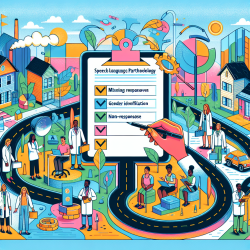Understanding Gender Non-Response in Adolescent Surveys
In the realm of speech-language pathology, the importance of understanding the nuanced needs of children cannot be overstated. A recent study titled "Are You a Boy or a Girl?"—A Missing Response Analysis provides valuable insights into the complexities of gender identity questions in adolescent health surveys. This analysis sheds light on the implications of non-response to gender-related questions and offers practitioners a pathway to enhance their skills and improve outcomes for children.
Key Findings from the Research
The study analyzed data from 54,833 adolescents across six countries, focusing on their responses to questions about age and gender. The participants were categorized into three groups:
- Responders: Answered both age and gender questions.
- Age Non-Responders: Did not answer the age question.
- Gender Non-Responders: Answered the age question but not the gender question.
Notably, 98.0% were responders, 1.6% were age non-responders, and 0.4% were gender non-responders. The study found that gender non-responders reported more psychosomatic complaints, frequent substance use, and lower family support compared to responders. These findings highlight significant health disparities that warrant further exploration and action.
Implications for Practitioners
For practitioners, these findings underscore the importance of creating inclusive environments that acknowledge and respect diverse gender identities. Here are some actionable steps practitioners can take:
- Inclusive Language: Use gender-neutral language in assessments and interactions to ensure all children feel represented and understood.
- Training and Education: Engage in continuous professional development to better understand gender diversity and its impact on health and well-being.
- Advocacy: Advocate for the inclusion of more comprehensive gender identity questions in surveys and assessments to capture the full spectrum of gender experiences.
Encouraging Further Research
The study suggests that further research should adopt a nuanced approach, informed by insights from LGBTQ+ youth, to better measure sex assigned at birth and gender identity. Practitioners are encouraged to participate in or support research efforts that aim to fill the existing knowledge gaps regarding gender minorities and their unique needs.
Conclusion
Understanding the reasons behind gender non-response in surveys is crucial for developing effective interventions and support systems for gender-nonconforming youth. By implementing the insights from this research, practitioners can enhance their skills and contribute to better health outcomes for all children.
To read the original research paper, please follow this link: "Are You a Boy or a Girl?"—A Missing Response Analysis.










